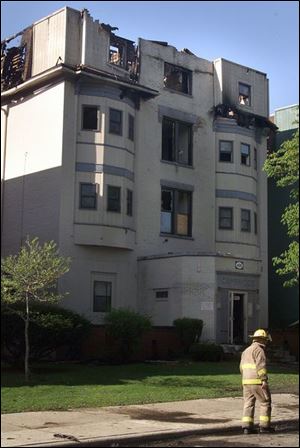
Central-city fire victims deal with their losses
4/27/2001
<xh>A firefighter passes by the Cambridge Apartments, 431 West Bancroft St., where a Wednesday night blaze rendered homeless 31 people.
Sharon Jones left her water-logged, first-floor unit in the Cambridge Apartments, 431 West Bancroft St., yesterday, holding a few containers filled with personal papers and medicine.
She was wearing the same clothes in which she fled the burning central-city building the night before. She borrowed her shoes from her mother.
“My new furniture is destroyed. Everything's gone,” the 41-year-old mother of four said amid tears.
Thirty people had similar stories after a suspicious fire caused about $600,000 damage as it ripped through the top of the four-story structure that is part of the apartment complex known as Bancroft Court.
Fire officials are investigating what caused a three-alarm blaze that they think started in the northeast corner of the building between the third and fourth floors, and burst through the roof about 7:40 p.m. Wednesday.
It was the second fire within a month at one of Bancroft Court's six apartment buildings. A fire caused about $40,000 damage to an adjacent four-story apartment building, Oxford Apartments, 435 Bancroft, on March 25.
Fire authorities think the blaze in March was set deliberately. They don't think the two fires are related.
Meanwhile, other officials are handling the aftermath.
“We're dealing with a really tough mental-health situation. The kids were having a hard time dealing with this,” said Scott Davis, director of emergency services for the Greater Toledo Chapter of the American Red Cross.
He said some of the victims lived at 435 West Bancroft before the building caught fire last month. They were moved to 431 West Bancroft and are again dealing with finding a place to live because of a blaze. Mr. Davis said his agency has spent at least $9,000 on housing, clothing, food, medicine, and other supplies to help the victims of Wednesday's fire. Rick Maxfield, a disaster specialist with the local Red Cross, walked through each apartment determining what the residents would need, such as beds and dressers. Vouchers will be given to the victims to purchase clothing and other necessities.
Building manager Dennis Bobo said PM1 Management, which owns the Bancroft Court structures, will try to house some of the victims in other apartments. He said the building is insured. “It's just been a nightmare. A lot of lives could have been lost,” Mr. Bobo said. Luckily, no one was hurt.
West Bancroft between Collingwood Boulevard and Ashland Avenue remained closed much of the day as fire crews watched for possible rekindling of the fire.
“The roof collapsed onto the fourth floor. It's like a sandwich up there,” Battalion Fire Chief Jerry Abair said.
More than 75 firefighters and more than 20 pieces of equipment assisted in trying to douse the flames.
Some off-duty Toledo firefighters were recalled to duty, and the city relied on its mutual aid pacts with surrounding communities to tap manpower and equipment to staff stations, replacing the firefighters who were sent to the apartment blaze.
Tom Dugan, president of Toledo Fire Fighters Local 92, said the city needs to have more firefighters on duty daily and better equipment. He said other cities of comparable size have more ladder trucks and personnel daily per square mile than Toledo.
Mr. Dugan said daily manpower has decreased over the last 30 years even though fire and medical runs have nearly doubled.
In 1965, 140 firefighters were in the city each day. They handled about 24,000 runs a year. Today, 103 firefighters work daily. They make 46,000 to 50,000 runs a year, he said.
“They are saying the number is an acceptable risk. For the firefighters and citizens, their life or health is not an acceptable risk,” Mr. Dugan said.
Fire Chief Mike Bell disagreed. Chief Bell said he can't justify increasing daily staffing levels when the department is efficiently handling its daily runs.
“If we had 110 firefighters every day, it wouldn't have made a difference [Wednesday]. If we had 120, we still would have had to call for help,” he said, adding that most large cities rely on mutual aid with other communities in times of big fires.
Chief Bell said the department had about 112 people on duty yesterday, nine more than the minimum required daily. And, 11 days last month, the department went without responding to any fires. When more crews are needed, firefighters are recalled. But if they monitor their calls at home and don't pick up the phone, even on an emergency recall, that's one less person the department can rely on to help battle a blaze, the chief said.
Chief Bell said he is working with the union to arrange a pager system with about 20 firefighters who would be willing to return to duty when their pager goes off.